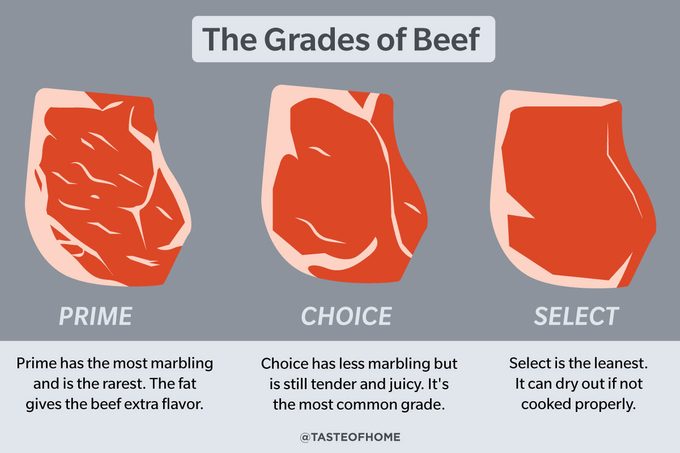What Are the Classes of Beef From Prime on Down
Select, prime, choice...what do grades of beef mean? And does the grade matter? A quick guide to understanding beef labels, plus when to save and when to splurge.
When shopping for beef, you've probably noticed that butchers label the beef with grades: premium, select, choice, canner.
Plenty of butchers will boast about their best cuts of beef (these are the best cuts of meat every home cook should know), but what exactly do the grades of beef mean? And does it always matter which grade you buy? Here's a quick guide to what beef grades really mean.
How Is Beef Graded?
USDA beef graders inspect beef to assess its safety and grade its quality. A quality grading allows better pieces of beef to sell for higher prices, which benefits farmers. It also gives consumers a standardized ranking system to guide their shopping.
Two considerations go into grades. First, how much marbling, or the fat between lean muscles, appears in the beef. Marbled beef generally has a richer flavor and will remain moist after cooking. Second, graders consider the age of the cow, since younger cattle tend to produce more tender beef.
Before you head to the butcher, check out these butcher counter tips for getting the best meat and deals.
The Grades of Beef

There are eight grades of beef: prime, choice, select, standard, commercial, utility, cutter and canner. Interestingly, only the first three are commonly sold at the butcher's shop. Here's a quick guide to each:
Prime
Just 4-5% of cattle makes the prime grade. Prime beef comes from young cows. The meat is amply marbled, with lots of white fat running through the beef. Fat might sound unappealing, but it's what gives beef much of its flavor and juiciness. Wagyu beef, which is famous for its intricate marbling and highly regulated cow breeds, is one example of prime beef.
Here's more on what wagyu beef is and what makes it so special.
Prime beef tends to be bought by high-end restaurants, hotels and steakhouses. Occasionally, your butcher shop may have prime beef in stock. It'll likely be a splurge, but the richness is perfect for a special occasion. Prime beef should be cooked quickly at high temperatures to preserve its incredible taste and texture: think grilled and seared steaks.
Browse this guide on how to cook steak to make the most of your top-graded beef.
Choice
About 65% of graded beef is choice, and it's the most common grade you're likely to see at your grocery store. Choice beef has moderate marbling and is perfectly tender, flavorful and juicy. Buying a choice steak or ribeye is certainly cheaper than a prime option that will still result in a perfectly delicious piece of beef, as long as you avoid these common mistakes when cooking steak.
Select
About 25% of beef is graded select. Select beef has less fat, which tends to mean it has less flavor and moisture. Select beef typically still has a good texture.
Cooking lean beef over high heat can run the risk of a dry, tough piece of meat. If you're grilling, roasting or broiling select beef, marinate it first to preserve moisture.
Select beef will taste great in a slow cooker, too. Certain cuts, like brisket, stew meats or ground beef, are just as tasty in a select grade as in a higher grade; they tend to be fattier cuts anyway, and are nearly always cooked low-and-slow, so they won't dry out. Try them in one of our favorite slow cooker beef recipes.
Standard, Commerical, Utility, Cutter and Canner
These lower-grade cuts of beef are seldom sold fresh to consumers. Only about 1% of beef is graded at this level, and it typically comes from older cattle. That's not to say this beef is inedible. It's commonly used in canned and processed food, or occasionally in cheap ground beef.
Now that you're an expert at interpreting beef grades, try whipping up one of these quick and easy beef dinner recipes.
Source: https://www.tasteofhome.com/article/what-are-the-grades-of-beef-and-which-one-should-i-buy/
0 Response to "What Are the Classes of Beef From Prime on Down"
Post a Comment